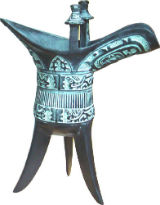- Lead: discovery and industry development
 Lead was one of the earliest metals to be used by people in ancient times. Early populations recognized the existence of lead some 7000 years ago, while by 3000 BC people had already discovered how to smelt lead from ore. A statue made from lead dating from 3000 BC , found in Abydos mosque in Egypt, was collected by the British Museum. Some records made in cuneiform and clay plates have proved that a large amount of iron, copper, silver and lead had been extracted from ore by 2350 BC. Between 1792 BC and 1750 BC, mass production of lead was started.
Lead was one of the earliest metals to be used by people in ancient times. Early populations recognized the existence of lead some 7000 years ago, while by 3000 BC people had already discovered how to smelt lead from ore. A statue made from lead dating from 3000 BC , found in Abydos mosque in Egypt, was collected by the British Museum. Some records made in cuneiform and clay plates have proved that a large amount of iron, copper, silver and lead had been extracted from ore by 2350 BC. Between 1792 BC and 1750 BC, mass production of lead was started.- Lead mining in the upper Mississippi River region of the US in 1865
 Lead has been commonly used for thousands of years because it is widespread, easy to extract and easy to work with. It is highly malleable as well as easy to smelt. Metallic lead beads dating back to 6400 BCE have been found in Çatalhöyük in modern-day Turkey. In the early Bronze Age, lead was used with antimony and arsenic. In China, lead as an alloy element had been found in bronze ware of the Erlitou culture. And lead, together with tin, constituted the most important alloy element for bronze ware during the Bronze Age. Some drinking vessels made in lead were also found in graves from the Yin Dynasty in China.
Lead has been commonly used for thousands of years because it is widespread, easy to extract and easy to work with. It is highly malleable as well as easy to smelt. Metallic lead beads dating back to 6400 BCE have been found in Çatalhöyük in modern-day Turkey. In the early Bronze Age, lead was used with antimony and arsenic. In China, lead as an alloy element had been found in bronze ware of the Erlitou culture. And lead, together with tin, constituted the most important alloy element for bronze ware during the Bronze Age. Some drinking vessels made in lead were also found in graves from the Yin Dynasty in China.- The largest preindustrial producer of lead was the Roman economy, with an estimated annual output of 80,000 tonnes, which was typically derived as a by-product of extensive silver smelting. Roman mining activities occurred in Central Europe, Roman Britain, the Balkans, Greece, Asia Minor and Hispania (which alone accounted for 40% of world production).
- In Europe, from Greek and Roman times right up to the 16th century, before making pencils using graphite, the ancients had clamped lead in wood to write, which is the origin of the word “pencil”. With its corrosion resistance, lead was used to make the roofs of churches and houses in lead-rich countries, including America, from the late Middle Ages. Originally, the lead-chamber process used for making sulfate was also due to its corrosion resistance properties.
- Because of the environmental pollution caused by lead, its application was severely reduced in the 1980s. Nowadays, gasoline, fuel, soldering and conduit are commonly produced without lead.
 In recent years, the lead industry has developed hugely due to its impressive properties. The records of the International Lead and Zinc Study Group showed that in 2011, global refined lead production was 10.372 million tonnes, and consumption was 10.216 million tonnes. Eighty percent of the lead produced in the world goes into lead accumulators. And as the life span of batteries is 5-15 years, the lead recycling industry is also developing apace. In developed countries, lead recycling has matured as an industry, while in some developing countries, a range of problems still exist. For instance, in China, during the ongoing process of lead and zinc smelting's industrial development, problems such as structural contradiction, the low degree of resource security, lacking prices setting power on products and some other problems still exist. Therefore, it is vital that industry reforms are strengthened if sustainable development of the lead and zinc smelting industry is to be realized in China.
In recent years, the lead industry has developed hugely due to its impressive properties. The records of the International Lead and Zinc Study Group showed that in 2011, global refined lead production was 10.372 million tonnes, and consumption was 10.216 million tonnes. Eighty percent of the lead produced in the world goes into lead accumulators. And as the life span of batteries is 5-15 years, the lead recycling industry is also developing apace. In developed countries, lead recycling has matured as an industry, while in some developing countries, a range of problems still exist. For instance, in China, during the ongoing process of lead and zinc smelting's industrial development, problems such as structural contradiction, the low degree of resource security, lacking prices setting power on products and some other problems still exist. Therefore, it is vital that industry reforms are strengthened if sustainable development of the lead and zinc smelting industry is to be realized in China.
-
About us
Contact us
Make a suggestion
- Metalpedia is a non-profit website, aiming to broaden metal knowledge and provide extensive reference database to users. It provides users reliable information and knowledge to the greatest extent. If there is any copyright violation, please notify us through our contact details to delete such infringement content promptly.
 Lead was one of the earliest metals to be used by people in ancient times. Early populations recognized the existence of lead some 7000 years ago, while by 3000 BC people had already discovered how to smelt lead from ore. A statue made from lead dating from 3000 BC , found in Abydos mosque in Egypt, was collected by the British Museum. Some records made in cuneiform and clay plates have proved that a large amount of iron, copper, silver and lead had been extracted from ore by 2350 BC. Between 1792 BC and 1750 BC, mass production of lead was started.
Lead was one of the earliest metals to be used by people in ancient times. Early populations recognized the existence of lead some 7000 years ago, while by 3000 BC people had already discovered how to smelt lead from ore. A statue made from lead dating from 3000 BC , found in Abydos mosque in Egypt, was collected by the British Museum. Some records made in cuneiform and clay plates have proved that a large amount of iron, copper, silver and lead had been extracted from ore by 2350 BC. Between 1792 BC and 1750 BC, mass production of lead was started. Lead has been commonly used for thousands of years because it is widespread, easy to extract and easy to work with. It is highly malleable as well as easy to smelt. Metallic lead beads dating back to 6400 BCE have been found in Çatalhöyük in modern-day Turkey. In the early Bronze Age, lead was used with antimony and arsenic. In China, lead as an alloy element had been found in bronze ware of the Erlitou culture. And lead, together with tin, constituted the most important alloy element for bronze ware during the Bronze Age. Some drinking vessels made in lead were also found in graves from the Yin Dynasty in China.
Lead has been commonly used for thousands of years because it is widespread, easy to extract and easy to work with. It is highly malleable as well as easy to smelt. Metallic lead beads dating back to 6400 BCE have been found in Çatalhöyük in modern-day Turkey. In the early Bronze Age, lead was used with antimony and arsenic. In China, lead as an alloy element had been found in bronze ware of the Erlitou culture. And lead, together with tin, constituted the most important alloy element for bronze ware during the Bronze Age. Some drinking vessels made in lead were also found in graves from the Yin Dynasty in China. In recent years, the lead industry has developed hugely due to its impressive properties. The records of the International Lead and Zinc Study Group showed that in 2011, global refined lead production was 10.372 million tonnes, and consumption was 10.216 million tonnes. Eighty percent of the lead produced in the world goes into lead accumulators. And as the life span of batteries is 5-15 years, the lead recycling industry is also developing apace. In developed countries, lead recycling has matured as an industry, while in some developing countries, a range of problems still exist. For instance, in China, during the ongoing process of lead and zinc smelting's industrial development, problems such as structural contradiction, the low degree of resource security, lacking prices setting power on products and some other problems still exist. Therefore, it is vital that industry reforms are strengthened if sustainable development of the lead and zinc smelting industry is to be realized in China.
In recent years, the lead industry has developed hugely due to its impressive properties. The records of the International Lead and Zinc Study Group showed that in 2011, global refined lead production was 10.372 million tonnes, and consumption was 10.216 million tonnes. Eighty percent of the lead produced in the world goes into lead accumulators. And as the life span of batteries is 5-15 years, the lead recycling industry is also developing apace. In developed countries, lead recycling has matured as an industry, while in some developing countries, a range of problems still exist. For instance, in China, during the ongoing process of lead and zinc smelting's industrial development, problems such as structural contradiction, the low degree of resource security, lacking prices setting power on products and some other problems still exist. Therefore, it is vital that industry reforms are strengthened if sustainable development of the lead and zinc smelting industry is to be realized in China. 